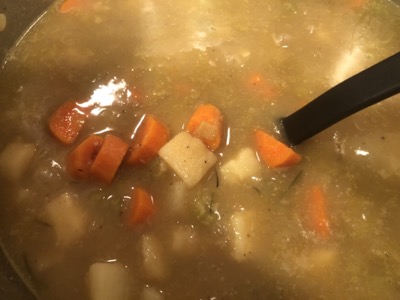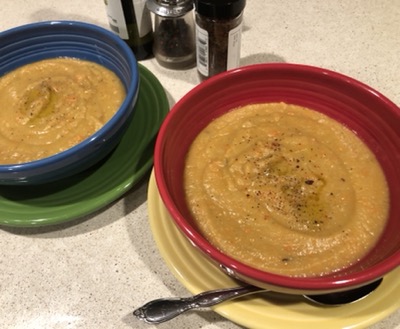
Recipe: Adapt the ingredients to your favorites

The soup is garnished with olive oil, black pepper, crushed Aleppo pepper and cooked bacon. Kathy Morrison
Rainy, then cold, then rainy AND cold – that’s been December so far. All I could think of to make the other day was soup – thick, warming soup, to serve with a big crusty loaf of whole wheat bread.
The New York Times Cooking app came to my rescue, with this easy root vegetable soup that I’ve adapted to boost the flavors. Depending on what you like and/or have in the pantry, the soup can include regular or sweet potatoes, parsnips, rutabagas, turnips, carrots or celery root. These combine with the usual aromatics of onions or leeks, plus garlic and celery.
I like potato-leek soup just fine, and could have gone with just russets, but wanted to make the flavors a little richer, so I included carrots and parsnips in my version. I used 4 potatoes, 3 carrots and 2 large parsnips, for a total of 3-½ pounds of root vegetables before peeling.
I also make and freeze my own vegetable stock, but added some chicken broth and a half-cup of white wine to fill out the liquid needed. And since this was going to be dinner, I cooked a bit of chopped bacon first, then used the fat to brown the onion and leeks. The bacon became the final garnish for a delicious warm meal.
The soup cooks fairly quickly – less an hour, after all the peeling and chopping is done. I used my immersion blender to smooth it all out, but leave it chunky if you like, or maybe blend just half of it.
The bacon, incidentally, is optional, as is just about everything in this recipe. However, I highly recommend a sprinkle of Aleppo crushed red pepper – or any crushed red pepper – as part of the garnish. It gives the soup a delightful pop of heat, and heat is what we all need these chilly days!
Root vegetable soup
Serves 6 to 8
Ingredients:
4 slices of bacon, cut into small pieces, or 3 tablespoons olive oil or butter
1 onion or 2 leeks, or both, trimmed and chopped
3 stalks celery, chopped
3 cloves garlic, smashed and minced
3 sprigs rosemary or thyme
2 bay leaves
Salt
Black pepper
½ cup white wine, optional

8 cups vegetable or chicken broth, or a combination, divided
3-½ pounds of root vegetables, peeled and chopped (a combination of any of these: russet potatoes, sweet potatoes, parsnips, rutabagas, turnips, carrots or celery root)
Juice of ½ lemon
Garnish options:
Freshly ground black pepper
Extra-virgin olive oil
Aleppo pepper flakes or other red pepper flakes
Grated Parmesan cheese
Additional lemon juice
Cooked bacon pieces, reserved from above
Instructions:
If using the bacon, cook it over medium heat in a large, heavy Dutch oven or soup pot until crispy, then remove the cooked bacon and reserve. Otherwise, heat the 3 tablespoons of olive oil or butter in the pot.

Cook the chopped onion and/or leeks and celery in fat until tender, up to 10 minutes, stirring occasionally. Then add the garlic, rosemary or thyme stalks, and the bay leaves, cooking for another minute.
Stir in the white wine if using, then about 2 cups of the broth. Add 2 teaspoons salt and ½ teaspoon black pepper. Stir well. Set aside 1 cup of the rest of the broth for later, then add the remaining 5 cups broth and the chopped root vegetables.
Bring the mixture to a boil, then lower heat and simmer for 30 to 40 minutes until the vegetables are tender. Taste the broth and adjust the seasonings.
Remove the soup from the heat and let it cool slightly. Remove the herb stalks and the bay leaves from the pot. Purée all or some of the soup with an immersion blender or in batches using a regular blender. Return to low heat, and if the soup seems too thick, add the reserved 1 cup broth and heat gently. (Be careful with hot soup! The purée can volcano out of the pot; I have a burn to prove it.) Stir in the lemon juice.
Serve soup in warmed bowls with a drizzle of olive oil and a grinding of black pepper, plus, as desired, a pinch of Aleppo pepper, a few drops of lemon juice, a sprinkling of Parmesan and/or some bacon pieces.
Comments
0 comments have been posted.Sacramento Digs Gardening to your inbox.
Sites We Like
Garden Checklist for week of April 21
This week there’s plenty to keep gardeners busy. With no rain in the immediate forecast, remember to irrigate any new transplants.
* Weed, weed, weed! Get them before they flower and go to seed.
* April is the last chance to plant citrus trees such as dwarf orange, lemon and kumquat. These trees also look good in landscaping and provide fresh fruit in winter.
* Smell orange blossoms? Feed citrus trees with a low dose of balanced fertilizer (such as 10-10-10) during bloom to help set fruit. Keep an eye out for ants.
* Apply slow-release fertilizer to the lawn.
* Thoroughly clean debris from the bottom of outdoor ponds or fountains.
* Spring brings a flush of rapid growth, and that means your garden is really hungry. Feed shrubs and trees with a slow-release fertilizer. Or mulch with a 1-inch layer of compost.
* Azaleas and camellias looking a little yellow? If leaves are turning yellow between the veins, give them a boost with chelated iron.
* Trim dead flowers but not leaves from spring-flowering bulbs such as daffodils and tulips. Those leaves gather energy to create next year's flowers. Also, give the bulbs a fertilizer boost after bloom.
* Pinch chrysanthemums back to 12 inches for fall flowers. Cut old stems to the ground.
* Mulch around plants to conserve moisture and control weeds.
* From seed, plant beans, beets, cantaloupes, carrots, corn, cucumbers, melons, radishes and squash.
* Plant onion sets.
* In the flower garden, plant seeds for asters, cosmos, celosia, marigolds, salvia, sunflowers and zinnias.
* Transplant petunias, zinnias, geraniums and other summer bloomers.
* Plant perennials and dahlia tubers for summer bloom.
* Mid to late April is about the last chance to plant summer bulbs, such as gladiolus and tuberous begonias.
* Transplant lettuce seedlings. Choose varieties that mature quickly such as loose leaf.